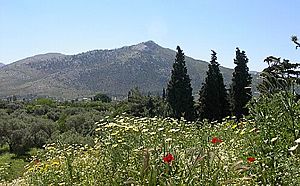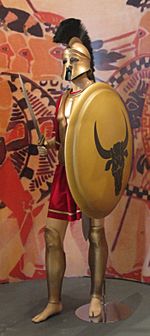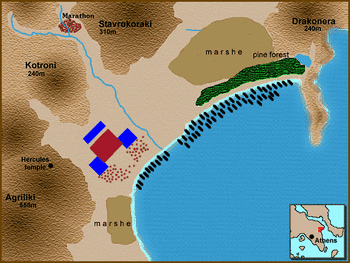Battle of Marathon facts for kids
Quick facts for kids Battle of Marathon |
|||||||
|---|---|---|---|---|---|---|---|
| Part of the Greco-Persian Wars | |||||||
 The plain of Marathon today |
|||||||
|
|||||||
| Belligerents | |||||||
| Athens, Plataea |
Persian Empire | ||||||
| Commanders and leaders | |||||||
| Miltiades the Younger, Callimachus † |
Datis Artaphernes |
||||||
| Strength | |||||||
| 9,000 – 10,000 Athenians, 1,000 Plataeans |
20,000 – 100,000 infantry and 1,000 cavalry (modern estimates) 600 ships, 200,000 – 600,000 infantry, and 10,000 cavalry (various ancient accounts) |
||||||
| Casualties and losses | |||||||
| 192 Athenians, 11 Plataeans (Herodotus) |
6,400 dead 7 ships destroyed (Herodotus) |
||||||
The Battle of Marathon was a very important battle fought in September 490 BC. It took place on the plain of Marathon in ancient Greece. The battle was between the city-state of Athens and the powerful Persian Empire. A small group of soldiers from the city of Plataea also helped Athens.
This battle marked the end of the first time Persia tried to conquer Greece. It was a key part of the Greco-Persian Wars. The Persian invasion happened because the Greeks had helped in a revolt. This was called the Ionian Revolt. Athens and Eretria had sent help to Greek cities in Ionia. These cities were trying to break free from Persian rule. The Athenians and Eretrians managed to capture and burn Sardis. But they had to retreat with many losses. Because of this, the Persian King Darius I swore to destroy Athens and Eretria.
Contents
Why the Persians Invaded Greece
After the Ionian revolt was stopped, King Darius started planning to conquer Greece. In 490 BC, he sent a large fleet of ships. Two commanders, Datis and Artaphernes, led this force. They sailed across the Aegean Sea to take over the Cyclades. These are a group of Greek islands. Their next goal was to attack Athens and Eretria.
The Persians had a successful campaign in the Aegean Sea. They then defeated, captured, and burned the city of Eretria. After that, the Persian army sailed towards Attica, which is the region around Athens.
The Battle at Marathon
The Persian ships landed on Schinias beach. This was on the east side of Marathon bay. The area was a wide, flat field. It was known as the plain of Marathon. This plain was perfect for a large battle. The Athenians, joined by soldiers from Plataea, marched to Marathon. They blocked the two ways out of the plain.
For five days, nothing much happened. Both armies just waited. Then, for reasons that are not fully clear, the Athenians decided to attack. The Persians had many more soldiers. But the Greek hoplites were very strong. Hoplites were heavily armed Greek foot soldiers. They were much more effective than the lighter-armed Persian infantry. The Greeks first defeated the Persian soldiers on the sides. Then they turned inwards to attack the center of the Persian line.
How the Battle Unfolded
When the Athenian army was ready, their leader, Miltiades, gave a simple command: "At them." The Greek soldiers likely marched forward. When they got close enough for the Persian archers to shoot, they started to run. This was about 200 meters away. Historians believe this was the first time a Greek army ran into battle like this. They probably did this to get through the arrows quickly.
The Persians were very surprised by this. The Greek soldiers ran through a shower of arrows. Their heavy armour protected them well. The Greek line crashed into the Persian army. It was a powerful impact. The Athenians were used to fighting other Greek armies. This meant shields crashing and spears hitting armor. But against the Persians, it was different. The Persians wore lighter protection. The Greek spears could stab again and again. Many Persians were crushed by the weight of the advancing Greek soldiers.
The Athenian soldiers on the sides quickly defeated the weaker Persian troops there. Then, these Greek soldiers turned inward. They surrounded the Persian center. The Persian center had been doing better against the thinner Greek center. But once surrounded, the Persian center broke. They panicked and ran towards their ships. The Greeks chased them. Some Persians ran into swamps and drowned. The Athenians chased the Persians all the way to their ships. They managed to capture seven ships. But most of the Persian ships were able to escape.
According to the historian Herodotus, 6,400 Persian soldiers died on the battlefield. We don't know how many more died in the swamps. The Athenians lost 192 men, and the Plataeans lost 11.
What Happened After Marathon
The defeat at Marathon was a huge victory for the Greeks. It marked the end of the first Persian invasion of Greece. The Persian army went back to Asia. King Darius then started to gather a massive new army. He planned to completely conquer Greece. However, in 486 BC, his subjects in Egypt revolted. This delayed his plans for Greece.
After Darius died, his son Xerxes I took over. He continued the preparations for a second invasion of Greece. This invasion finally began in 480 BC.
The Battle of Marathon was a turning point in the Greco-Persian Wars. It showed the Greeks that the powerful Persians could be defeated. The eventual Greek victory in these wars started at Marathon. The next two hundred years saw the rise of Classical Greek civilization. This period had a huge impact on Western society. Because of this, the Battle of Marathon is often seen as a very important moment in European history.
The Battle of Marathon is also famous as the inspiration for the Marathon race. There's a story, which isn't completely true, about a Greek messenger. He supposedly ran to Athens with the news of the victory. This legend inspired the marathon race. It was introduced at the 1896 Athens Olympics. The race originally ran between Marathon and Athens.
Images for kids
-
Darius I of Persia, as imagined by a Greek painter on the Darius Vase, 4th century BC
-
The different groups of soldiers in Darius I's army. This is shown on the tomb of Darius I at Naqsh-e Rostam.
-
A Greek Corinthian-style helmet and a skull. They were reportedly found together from the Battle of Marathon. Now at the Royal Ontario Museum.
-
A statue of Pan, a Greek god, from the Capitoline Museum, Rome.
See also
 In Spanish: Batalla de Maratón para niños
In Spanish: Batalla de Maratón para niños


















